

Compact Muon Solenoid
LHC, CERN
| CMS-B2G-18-007 ; CERN-EP-2019-135 | ||
| Search for physics beyond the standard model in events with overlapping photons and jets | ||
| CMS Collaboration | ||
| 14 July 2019 | ||
| Phys. Rev. Lett. 123 (2019) 241801 | ||
| Abstract: Results are reported from a search for new particles that decay into a photon and two gluons, in events with jets. Novel jet substructure techniques are developed that allow photons to be identified in an environment densely populated with hadrons. The analyzed proton-proton collision data were collected by the CMS experiment at the LHC, in 2016 at $\sqrt{s} = $ 13 TeV, and correspond to an integrated luminosity of 35.9 fb$^{-1}$. The spectra of total transverse hadronic energy of candidate events are examined for deviations from the standard model predictions. No statistically significant excess is observed over the expected background. The first cross section limits on new physics processes resulting in such events are set. The results are interpreted as upper limits on the rate of gluino pair production, utilizing a simplified stealth supersymmetry model. The excluded gluino masses extend up to 1.7 TeV, for a neutralino mass of 200 GeV and exceed previous mass constraints set by analyses targeting events with isolated photons. | ||
| Links: e-print arXiv:1907.06275 [hep-ex] (PDF) ; CDS record ; inSPIRE record ; CADI line (restricted) ; | ||
| Figures & Tables | Summary | Additional Figures | References | CMS Publications |
|---|
| Figures | |

png pdf |
Figure 1:
The decay diagram for a single gluino predicted by stealth SUSY. This analysis searches for pair produced gluinos and thus two such decay chains are expected in each signal event. The $S$ and $\tilde{S}$ states are assumed to have a small mass splitting, resulting in soft $\tilde{\mathrm{G}}$ emissions. This analysis mainly explores cases where the mass difference between the ${\mathrm{\widetilde{g}}}$ and $\tilde{\chi}^0_1$ is large and results in a high momentum $\tilde{\chi}^0_1$ with the photon and gluons merging into a single jet which we refer to as a photon jet. |
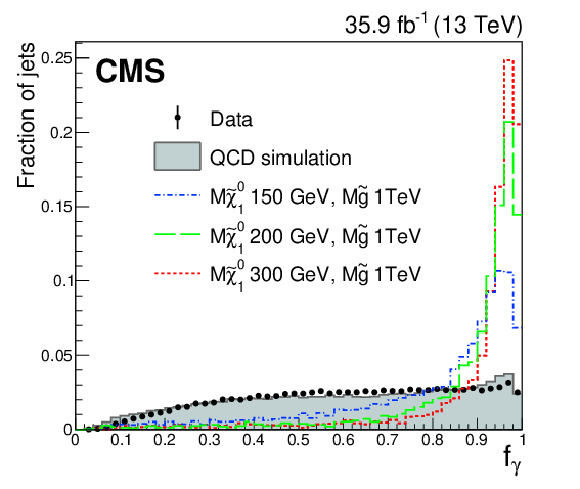
png pdf |
Figure 2:
Distribution of the photon subjet energy fraction (${f_{\gamma}}$). Simulated distributions for signal are denoted by the broken lines, each depicting a different mass of $\tilde{\chi}^0_1$ and ${\mathrm{\widetilde{g}}}$. The shaded area represents the QCD jets distribution. The points with error bars represent data. The distributions are for jets that satisfy the loose photon jet requirements. |

png pdf |
Figure 3:
The ${H_{\mathrm {T}}}$ distributions in the signal regions for the 3-jet AK8 (upper row) and the $\geq $4 AK8 jets categories (lower row). Events with zero, one and two tight photon jets are presented from left to right. The black points with error bars denote the ${H_{\mathrm {T}}}$ distributions observed in data. The magenta line with the gray band corresponds to the background expectation obtained from data while the blue and red colored lines present two signal benchmarks. The lower panels present the data-to-background ratio with their respective uncertainties. In the $\geq $4 jets 2-2 category we observe 0 events. |

png pdf |
Figure 3-a:
The ${H_{\mathrm {T}}}$ distributions in the signal regions for the 3-jet AK8 categories. Events with zero, one and two tight photon jets are presented from left to right. The black points with error bars denote the ${H_{\mathrm {T}}}$ distributions observed in data. The magenta line with the gray band corresponds to the background expectation obtained from data while the blue and red colored lines present two signal benchmarks. The lower panels present the data-to-background ratio with their respective uncertainties. |

png pdf |
Figure 3-b:
The ${H_{\mathrm {T}}}$ distributions in the signal regions for the $\geq $4 AK8 jets categories. Events with zero, one and two tight photon jets are presented from left to right. The black points with error bars denote the ${H_{\mathrm {T}}}$ distributions observed in data. The magenta line with the gray band corresponds to the background expectation obtained from data while the blue and red colored lines present two signal benchmarks. The lower panels present the data-to-background ratio with their respective uncertainties. In the $\geq $4 jets 2-2 category we observe 0 events. |
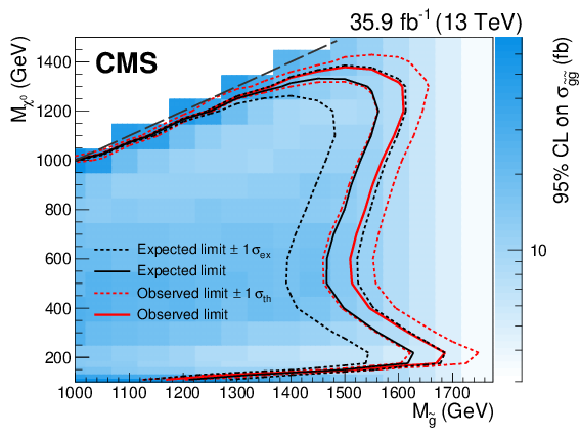
png pdf |
Figure 4:
The upper limit at 95% confidence level on the ${\mathrm{\widetilde{g}}}$ pair production cross section as a function of ${\mathrm{\widetilde{g}}}$ and $\tilde{\chi}^0_1$ masses. The region enclosed by the red (lighter) solid line is excluded. The black (darker) solid line presents the expected excluded area based on the background estimate from control regions in data. The uncertainty in the observed limit corresponds to the theoretical uncertainties in the signal cross section. Exclusion in the low $\tilde{\chi}^0_1$ and high ${\mathrm{\widetilde{g}}}$ mass region, is a result of the implementation of the substructure techniques. |
| Tables | |
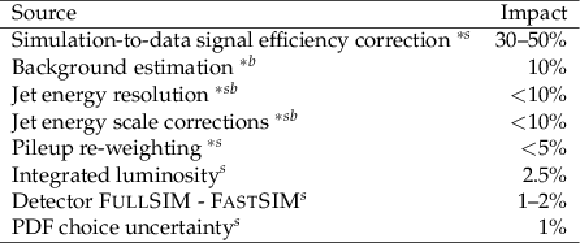
png pdf |
Table 1:
Impact of systematic uncertainties on either signal acceptance or background. Shape uncertainties are denoted by an asterisk (*), while the others are considered normalization uncertainties. Uncertainties that impact signal acceptance are denoted by "s" ($^s$) while "b" ($^b$) is used for background. |
| Summary |
| To summarize, a search for new particles decaying to a photon and two gluons in events with jets is presented. The search is performed in events with two jets that have substructure and are composed of a photon and two gluons. A data set of proton-proton collisions at a center-of-mass energy of 13 TeV collected by the CMS experiment, corresponding to an integrated luminosity of 35.9 fb$^{-1}$, is analyzed. To identify the candidate jets, novel jet substructure techniques have been developed and used to complement established methods. The total transverse hadronic activity distributions of events in the signal region are compared to the expected distributions, estimated from data. No statistically significant excess is observed above the standard model background expectation. We establish upper limits at 95% confidence level on the cross section for gluino pair production, using a simplified stealth SUSY model. The excluded gluino masses extend up to 1.5--1.7 TeV, depending on the neutralino mass, with the highest exclusion set for neutralinos with a mass of 200 GeV. This is the first search of this kind targeting the region of parameter space where photons from neutralino decays are not isolated and the limits set exceed previous gluino mass constraints from searches that did not employ jet substructure techniques. |
| Additional Figures | |

png pdf |
Additional Figure 1:
The signal efficiencies for gluinos (inverted triangles) and squarks (filled circles) as a function of neutralino mass for a gluino mass of 1.7 TeV and a squark mass of 1.7 TeV, respectively. The magenta markers correspond to the analysis approach followed in this paper, and the black markers correspond to the standard approach using isolated photons. The label WP80 denotes a selection on photons with an efficiency of 80% that includes a cut on isolation. The label LT 21+, referring to Loose - Tight photon jets, denotes a selection on events that have two Loose photon jets, at least one of which is a Tight photon jet. |
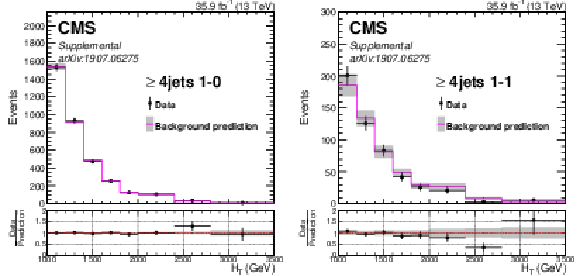
png pdf |
Additional Figure 2:
The standard model multijet background is estimated from data. The background ${H_{\mathrm {T}}}$ distributions, for each SR category are estimated by constructing an ${H_{\mathrm {T}}}$ distribution of all events in the background region and weighting each event by the calculated probabilities for it to pass the signal region selections. The validity of the background method is tested by confirming that there is agreement between prediction and observation for the numbers of events in the ${H_{\mathrm {T}}}$ distributions and for their shapes. The tests are performed both with simulated events and with a subset of the data corresponding to 10% of the total integrated luminosity. Shown here are the observed and expected ${H_{\mathrm {T}}} $distributions, for events with 1 Loose and zero Tight photon jets (left) and 1 Loose and 1 Tight photon jets (right). |

png pdf |
Additional Figure 2-a:
The standard model multijet background is estimated from data. The background ${H_{\mathrm {T}}}$ distributions, for each SR category are estimated by constructing an ${H_{\mathrm {T}}}$ distribution of all events in the background region and weighting each event by the calculated probabilities for it to pass the signal region selections. The validity of the background method is tested by confirming that there is agreement between prediction and observation for the numbers of events in the ${H_{\mathrm {T}}}$ distributions and for their shapes. The tests are performed both with simulated events and with a subset of the data corresponding to 10% of the total integrated luminosity. Shown here are the observed and expected ${H_{\mathrm {T}}} $distributions, for events with 1 Loose and zero Tight photon jets. |
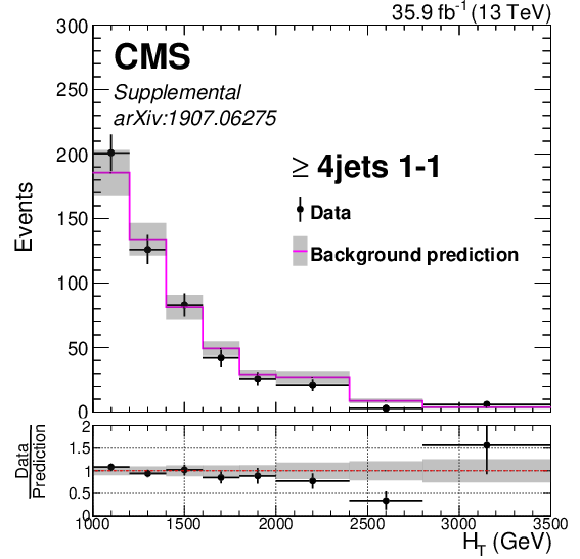
png pdf |
Additional Figure 2-b:
The standard model multijet background is estimated from data. The background ${H_{\mathrm {T}}}$ distributions, for each SR category are estimated by constructing an ${H_{\mathrm {T}}}$ distribution of all events in the background region and weighting each event by the calculated probabilities for it to pass the signal region selections. The validity of the background method is tested by confirming that there is agreement between prediction and observation for the numbers of events in the ${H_{\mathrm {T}}}$ distributions and for their shapes. The tests are performed both with simulated events and with a subset of the data corresponding to 10% of the total integrated luminosity. Shown here are the observed and expected ${H_{\mathrm {T}}} $distributions, for events with 1 Loose and 1 Tight photon jets. |
| References | ||||
| 1 | M. J. Strassler and K. M. Zurek | Echoes of a hidden valley at hadron colliders | PLB 651 (2007) 374 | hep-ph/0604261 |
| 2 | M. J. Strassler | Possible effects of a hidden valley on supersymmetric phenomenology | hep-ph/0607160 | |
| 3 | R. Barbier et al. | R-parity-violating supersymmetry | Phys. Repts. 420 (2005) 1 | hep-ph/0406039 |
| 4 | J. Fan, M. Reece, and J. T. Ruderman | A stealth supersymmetry sampler | JHEP 07 (2012) 196 | 1201.4875 |
| 5 | J. Fan, M. Reece, and J. T. Ruderman | Stealth supersymmetry | JHEP 11 (2011) 012 | 1105.5135 |
| 6 | J. Fan et al. | Stealth supersymmetry simplified | JHEP 07 (2016) 016 | 1512.05781 |
| 7 | CMS Collaboration | Search for stealth supersymmetry in events with jets, either photons or leptons, and low missing transverse momentum in pp collisions at 8 TeV | PLB 743 (2015) 503 | CMS-SUS-14-009 1411.7255 |
| 8 | CMS Collaboration | Search for supersymmetry in events with photons and low missing transverse energy in pp collisions at $ \sqrt{s}= $ 7 TeV | PLB 719 (2013) 42 | CMS-SUS-12-014 1210.2052 |
| 9 | CMS Collaboration | The CMS trigger system | JINST 12 (2017), no. 01, P01020 | CMS-TRG-12-001 1609.02366 |
| 10 | CMS Collaboration | The CMS experiment at the CERN LHC | JINST 3 (2008) S08004 | CMS-00-001 1206.4071 |
| 11 | CMS Collaboration | Particle-flow reconstruction and global event description with the CMS detector | JINST 12 (2017) P10003 | CMS-PRF-14-001 1706.04965 |
| 12 | M. Cacciari, G. P. Salam, and G. Soyez | The anti-$ {k_{\mathrm{T}}} $ jet clustering algorithm | JHEP 04 (2008) 063 | 0802.1189 |
| 13 | M. Cacciari, G. P. Salam, and G. Soyez | FastJet user manual | EPJC 72 (2012) 1896 | 1111.6097 |
| 14 | CMS Collaboration | Jet algorithms performance in 13 TeV data | CMS-PAS-JME-16-003 | CMS-PAS-JME-16-003 |
| 15 | CMS Collaboration | Identification and filtering of uncharacteristic noise in the CMS hadron calorimeter | JINST 5 (2010) T03014 | CMS-CFT-09-019 0911.4881 |
| 16 | CMS Collaboration | Jet energy scale and resolution in the CMS experiment in pp collisions at 8 TeV | JINST 12 (2017) P02014 | CMS-JME-13-004 1607.03663 |
| 17 | J. Alwall et al. | The automated computation of tree-level and next-to-leading order differential cross sections, and their matching to parton shower simulations | JHEP 07 (2014) 079 | 1405.0301 |
| 18 | T. Sjostrand et al. | An introduction to PYTHIA 8.2 | CPC 191 (2015) 159 | 1410.3012 |
| 19 | CMS Collaboration | Event generator tunes obtained from underlying event and multiparton scattering measurements | EPJC 76 (2016) 155 | CMS-GEN-14-001 1512.00815 |
| 20 | NNPDF Collaboration | Parton distributions with LHC data | NPB 867 (2013) 244 | 1207.1303 |
| 21 | S. Abdullin et al. | The fast simulation of the CMS detector at LHC | J. Phys. Conf. Ser. 331 (2011) 032049 | |
| 22 | A. Giammanco | The fast Simulation of the CMS Experiment | J. Phys. Conf. Ser. 513 (2014) 022012 | |
| 23 | GEANT4 Collaboration | GEANT4--a simulation toolkit | NIMA 506 (2003) 250 | |
| 24 | M. Bahr et al. | Herwig++ physics and manual | EPJC 58 (2008) 639 | 0803.0883 |
| 25 | S. Gieseke, C. Rohr, and A. Siodmok | Colour reconnections in Herwig++ | EPJC 72 (2012) 2225 | 1206.0041 |
| 26 | C. Borschensky et al. | Squark and gluino production cross sections in pp collisions at $ \sqrt{s} = $ 13, 14, 33 and 100 TeV | EPJC 74 (2014) 3174 | 1407.5066 |
| 27 | J. Alwall et al. | Comparative study of various algorithms for the merging of parton showers and matrix elements in hadronic collisions | EPJC 53 (2008) 473 | 0706.2569 |
| 28 | P. Nason | A new method for combining NLO QCD with shower Monte Carlo algorithms | JHEP 11 (2004) 040 | hep-ph/0409146 |
| 29 | S. Frixione, P. Nason, and C. Oleari | Matching NLO QCD computations with parton shower simulations: the POWHEG method | JHEP 11 (2007) 070 | 0709.2092 |
| 30 | S. Alioli, P. Nason, C. Oleari, and E. Re | A general framework for implementing NLO calculations in shower Monte Carlo programs: the POWHEG BOX | JHEP 06 (2010) 043 | 1002.2581 |
| 31 | S. Frixione, P. Nason, and G. Ridolfi | A positive-weight next-to-leading-order Monte Carlo for heavy flavour hadroproduction | JHEP 09 (2007) 126 | 0707.3088 |
| 32 | CMS Collaboration | Performance of photon reconstruction and identification with the CMS detector in proton-proton collisions at sqrt(s) = 8 TeV | JINST 10 (2015) P08010 | CMS-EGM-14-001 1502.02702 |
| 33 | S. Catani, Y. L. Dokshitzer, M. H. Seymour, and B. R. Webber | Longitudinally invariant $ {k_{\mathrm{T}}} $ clustering algorithms for hadron hadron collisions | NPB 406 (1993) 187 | |
| 34 | J. Thaler and K. Van Tilburg | Identifying boosted objects with $ N $-subjettiness | JHEP 03 (2011) 15 | 1011.2268 |
| 35 | CMS Collaboration | Identification of heavy-flavour jets with the CMS detector in pp collisions at 13 TeV | JINST 13 (2018) P05011 | CMS-BTV-16-002 1712.07158 |
| 36 | CMS Collaboration | Determination of jet energy calibration and transverse momentum resolution in CMS | JINST 6 (2011) | CMS-JME-10-011 1107.4277 |
| 37 | CMS Collaboration | CMS luminosity measurements for the 2016 data taking period | CMS-PAS-LUM-17-001 | CMS-PAS-LUM-17-001 |
| 38 | J. Butterworth et al. | PDF4LHC recommendations for LHC run II | JPG 43 (2016) 023001 | 1510.03865 |
| 39 | Particle Data Group Collaboration | Review of particle physics | PRD 98 (2018) 030001 | |

|
Compact Muon Solenoid LHC, CERN |

|

|

|

|

|

|